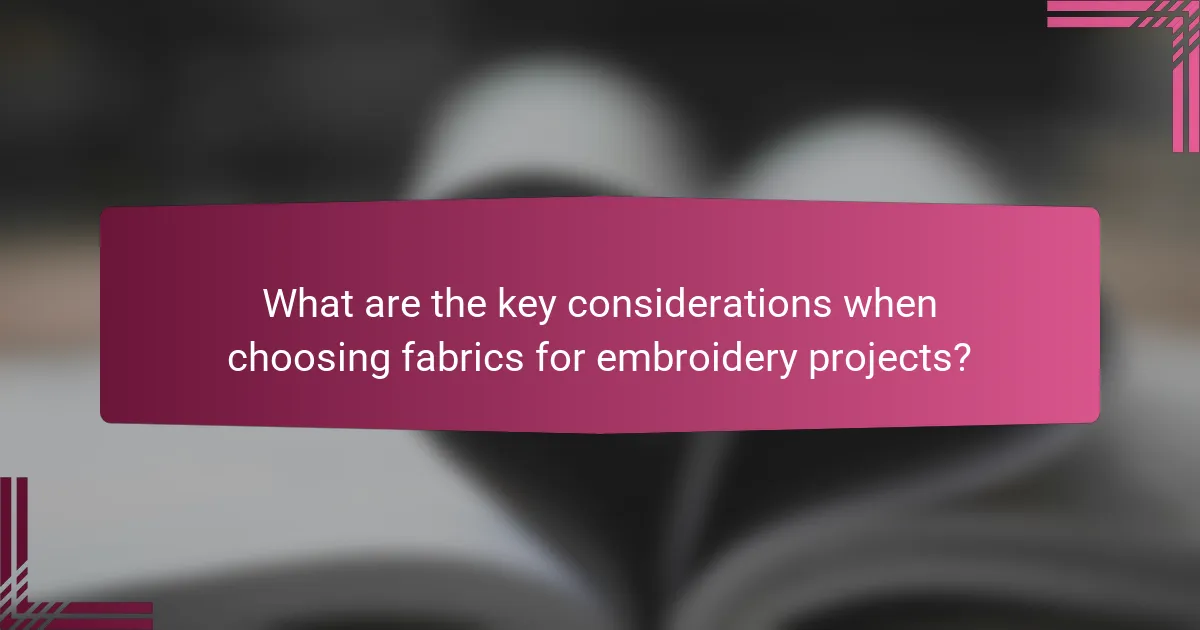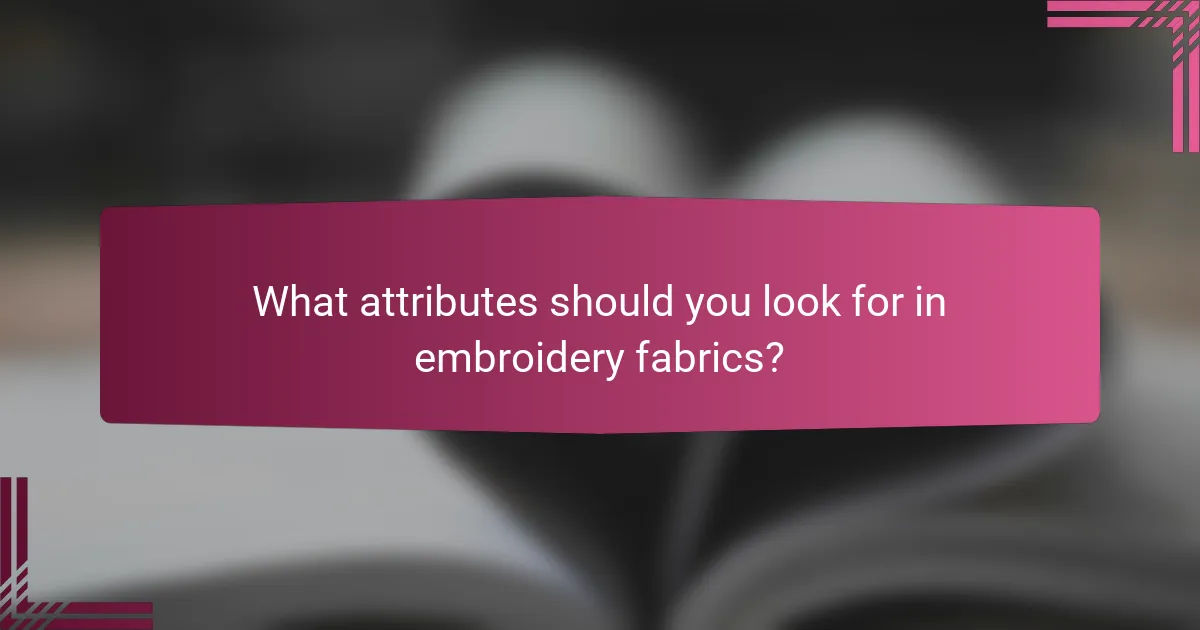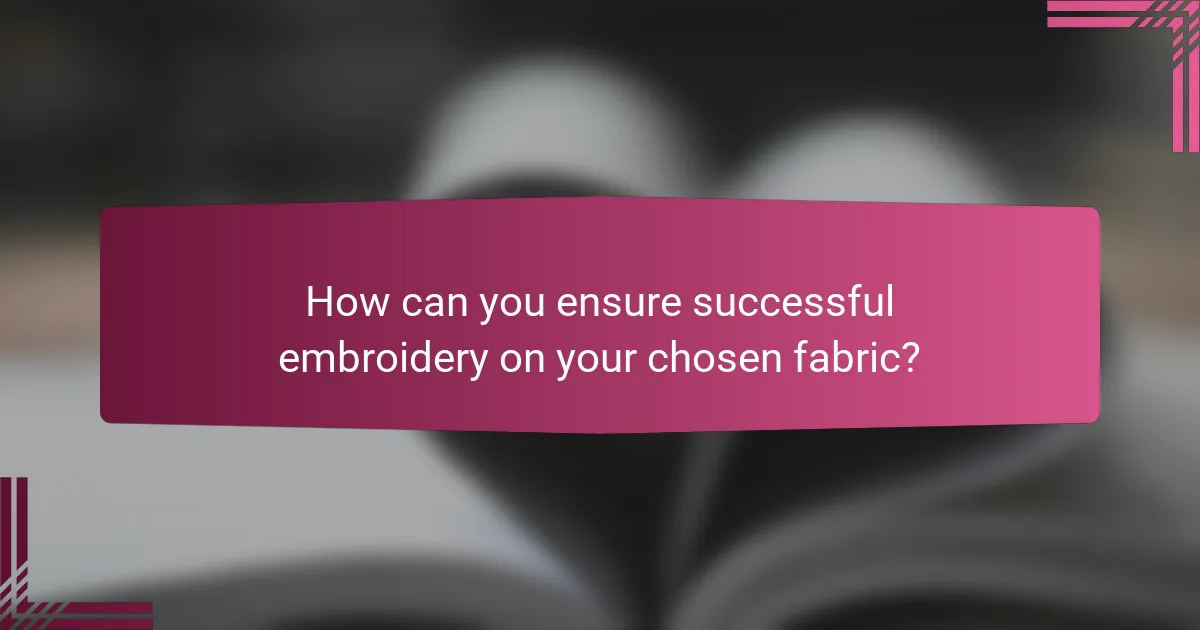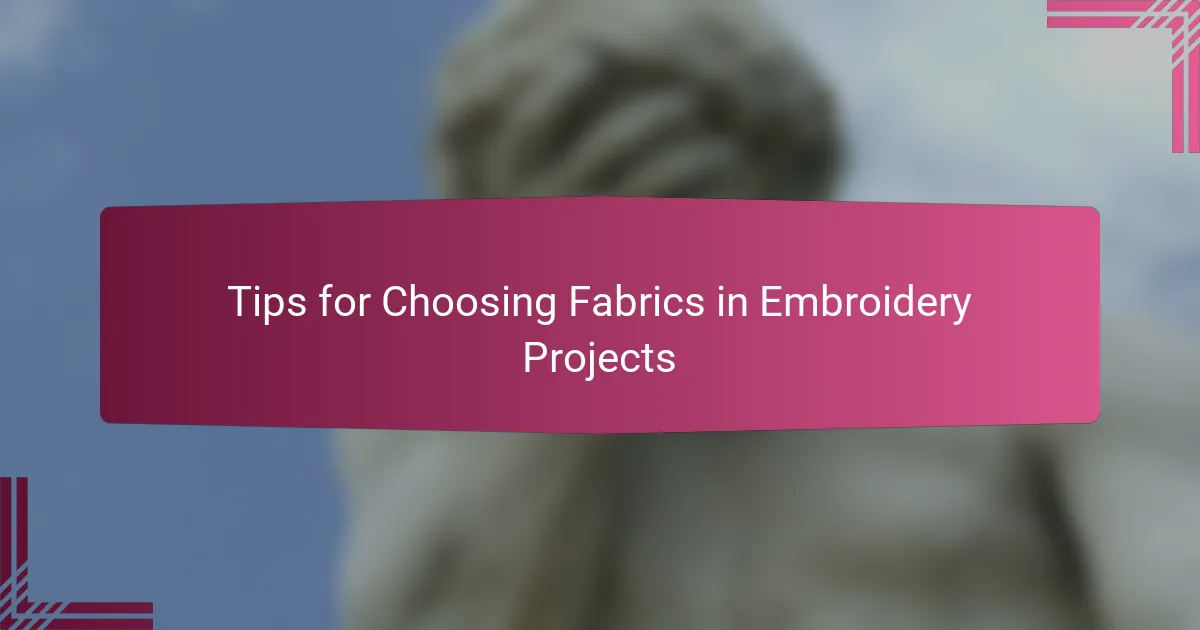
What are the key considerations when choosing fabrics for embroidery projects?
Key considerations when choosing fabrics for embroidery projects include fabric type, weight, and texture. The fabric type affects how well the embroidery will adhere and show. Common choices are cotton, linen, and polyester. Weight influences the stitch definition and durability of the finished piece. Heavier fabrics can support more intricate designs, while lighter fabrics may require stabilizers. Texture impacts the appearance of the embroidery. Smooth fabrics allow for precise stitching, while textured fabrics can create unique effects. Additionally, color plays a critical role in visibility and design impact. Finally, pre-washing fabrics is essential to prevent shrinkage and color bleeding after embroidery.
How does fabric type impact embroidery quality?
Fabric type significantly impacts embroidery quality. Different fabrics have varying textures, weights, and stretch levels. These characteristics influence how well the thread adheres to the fabric. For instance, tightly woven fabrics like denim provide a stable surface for embroidery. Conversely, stretchy fabrics like jersey can cause distortion during stitching. The thickness of the fabric also affects needle [censured] and thread tension. Thicker fabrics may require larger needles and stronger threads. Additionally, some fabrics may fray more easily, affecting the final appearance of the embroidery. Choosing the appropriate fabric type is essential for achieving clean, precise embroidery results.
What are the different types of fabrics suitable for embroidery?
Cotton, linen, polyester, silk, and canvas are different types of fabrics suitable for embroidery. Cotton is widely used due to its smooth texture and ease of handling. Linen offers a natural look and durability, making it ideal for intricate designs. Polyester is strong and resistant to wrinkles, suitable for various embroidery techniques. Silk provides a luxurious finish and vibrant colors, enhancing the overall appearance. Canvas is heavy-duty and perfect for bold designs and outdoor projects. Each fabric type supports different embroidery styles and techniques, ensuring versatility in projects.
How do fabric weights affect the embroidery process?
Fabric weights significantly influence the embroidery process. Heavier fabrics provide stability, reducing distortion during stitching. This stability helps maintain the design’s integrity and clarity. Lighter fabrics can shift or pucker, causing uneven stitching. Additionally, heavier fabrics often require stronger needles and threads. This ensures that the embroidery can penetrate the fabric without breakage. Proper fabric weight selection enhances the overall quality of the finished embroidery. Therefore, understanding fabric weights is crucial for successful embroidery projects.
Why is fabric texture important in embroidery projects?
Fabric texture is important in embroidery projects because it affects the final appearance and quality of the embroidery. Different textures can influence how well the thread adheres to the fabric. Smooth fabrics allow for cleaner, more defined stitches. Conversely, textured fabrics can create a more complex look but may lead to uneven stitching. Additionally, the texture can impact the durability of the embroidery. For instance, rougher textures may cause wear on the thread over time. Selecting the right fabric texture enhances the overall aesthetic and longevity of the embroidery.
What textures work best for different embroidery techniques?
Different textures complement various embroidery techniques. Smooth fabrics like cotton or silk are ideal for fine details and intricate designs. They allow for clean stitching and precise outlines. Textured fabrics such as linen work well for rustic or vintage styles. They add depth and a tactile quality to the finished piece. Canvas is suitable for bold, heavy designs. Its sturdiness supports larger stitches and embellishments. Knit fabrics can stretch, making them ideal for designs that require flexibility. Each texture enhances the visual appeal of the embroidery technique used.
How does texture influence the final appearance of the embroidery?
Texture significantly influences the final appearance of embroidery. It affects how light interacts with the fabric. Smooth textures create a sleek, polished look. Textured fabrics add depth and dimension to the design. Different thread types can enhance or soften the texture effect. For example, using glossy threads on a textured fabric can create contrast. Conversely, matte threads can blend more seamlessly. The choice of texture can also impact the overall feel of the piece. Ultimately, texture plays a crucial role in achieving the desired aesthetic in embroidery projects.

What attributes should you look for in embroidery fabrics?
When selecting embroidery fabrics, consider attributes such as weight, texture, and durability. Weight affects how the fabric drapes and supports the embroidery. A medium to heavy weight is often preferred for stability. Texture influences the visibility of the stitches; smoother fabrics showcase designs better. Durability ensures the fabric withstands the embroidery process and regular use. Additionally, consider the fabric’s fiber content. Natural fibers like cotton and linen are popular for their breathability and ease of stitching. Synthetic fibers can offer strength and resistance to fraying. Lastly, color and pattern can impact the final look of the embroidery. Choosing a fabric that complements the thread colors enhances the overall design.
How do fabric durability and washability affect embroidery choices?
Fabric durability and washability significantly influence embroidery choices. Durable fabrics withstand wear and tear, making them suitable for items like uniforms or workwear. Fabrics with high washability retain their appearance after multiple washes, ensuring the embroidery remains intact. For instance, cotton and polyester blends are known for their durability and washability. These attributes prevent fading and fraying of the embroidered design. Choosing fabrics that meet these criteria enhances the longevity of the finished product. Thus, the selection of fabric directly impacts the quality and lifespan of embroidered items.
What are the best practices for selecting durable fabrics?
Selecting durable fabrics involves considering material composition, weave structure, and care requirements. Look for fabrics made from natural fibers like cotton or synthetic blends for strength. Examine the weave; tighter weaves generally indicate better durability. Check the fabric’s weight; heavier fabrics are often more robust. Assess the fabric’s resistance to fading and wear, which can be influenced by dye quality. Consider the intended use of the fabric, as some applications require more durability than others. Always read care labels to ensure the fabric can withstand regular cleaning and usage. These practices help ensure long-lasting results in embroidery projects.
How should you assess washability for different fabrics?
To assess washability for different fabrics, start by checking the care label. The care label provides essential information on washing instructions, water temperature, and drying methods. Next, consider the fabric type. Natural fibers like cotton generally wash well, while delicate fabrics like silk require more care. Conduct a colorfastness test by dampening a small area and applying a white cloth to see if any dye transfers. Additionally, evaluate the fabric’s durability by observing its resistance to fraying and fading after washing. Finally, consult manufacturer guidelines or fabric swatches to understand the expected washability. These steps ensure that the fabric will maintain its quality after multiple washes.
What role does color play in fabric selection for embroidery?
Color significantly influences fabric selection for embroidery. It affects the visibility and contrast of the design. A well-chosen color enhances the overall aesthetic appeal. Color can also impact the mood and message conveyed by the embroidery. Fabrics in complementary colors will make the embroidery stand out more. Additionally, the color of the fabric can affect thread selection. The right color combination ensures clarity and vibrancy in the final piece. Studies show that color harmony increases viewer engagement and satisfaction.
How do colorfastness and dye types impact embroidery results?
Colorfastness and dye types significantly impact embroidery results. Colorfastness refers to the resistance of a dye to fading or running when exposed to water, light, or washing. High colorfastness ensures that the embroidery retains its vibrancy over time. Conversely, low colorfastness may lead to bleeding or fading, diminishing the design quality.
Dye types, such as reactive, disperse, or pigment dyes, also influence the final appearance. Reactive dyes bond chemically with fibers, providing bright colors and durability. Disperse dyes are ideal for synthetic fabrics, offering excellent color retention. Pigment dyes, while easy to apply, may not penetrate the fabric deeply, potentially affecting longevity.
Research indicates that fabrics treated with high colorfastness dyes maintain their appearance better after multiple washes. For example, a study published in the Journal of Textile Science found that reactive dyed cotton showed minimal color loss after 20 wash cycles, compared to significant fading in fabrics dyed with low colorfastness options. This highlights the importance of selecting appropriate dyes and understanding their properties for successful embroidery projects.
What are the best color combinations for different projects?
The best color combinations for different projects include complementary, analogous, and triadic schemes. Complementary colors are opposite each other on the color wheel, such as blue and orange. This combination creates high contrast and vibrant visuals. Analogous colors are next to each other on the wheel, like blue, blue-green, and green. These combinations provide a harmonious look. Triadic schemes use three evenly spaced colors, such as red, yellow, and blue. This approach offers balance and diversity. For embroidery projects, consider the fabric’s texture and sheen. Choosing the right color combination enhances the overall design and appeal.

How can you ensure successful embroidery on your chosen fabric?
To ensure successful embroidery on your chosen fabric, select the right type of fabric for your project. Fabrics like cotton and linen are ideal due to their stability and ease of stitching. Pre-wash your fabric to prevent shrinkage after embroidery. Use an appropriate stabilizer to support the fabric during stitching. Choose the correct needle size and type based on the fabric weight. Adjust the tension settings on your embroidery machine for optimal results. Lastly, conduct a test stitch on a scrap piece of the same fabric to check for any issues before starting the final design.
What preparation steps should be taken before embroidering on fabric?
Select the appropriate fabric for embroidery. Consider fabric weight and texture for the design. Pre-wash the fabric to remove sizing and prevent shrinkage. Iron the fabric to ensure a smooth, flat surface. Use stabilizer to support the fabric during stitching. Mark the embroidery design on the fabric accurately. Thread the needle with suitable embroidery floss or thread. Test the stitching on a scrap piece of the same fabric.
How do you prewash and stabilize fabric for embroidery?
Prewashing fabric for embroidery involves cleaning it to remove sizing and dirt. Start by washing the fabric in warm water with a mild detergent. Rinse thoroughly to ensure all detergent is removed. Dry the fabric either by air drying or using a dryer on a low setting. Stabilizing fabric is essential to prevent distortion during embroidery. Choose an appropriate stabilizer based on the fabric type and embroidery design. Apply the stabilizer according to the manufacturer’s instructions. For best results, hoop the fabric and stabilizer together before starting the embroidery process. This method ensures the fabric remains taut and the design is accurately executed.
What tools are essential for preparing fabric for embroidery?
Essential tools for preparing fabric for embroidery include fabric scissors, an iron, and a cutting mat. Fabric scissors are necessary for clean cuts without fraying. An iron is used to remove wrinkles and ensure the fabric lays flat. A cutting mat protects surfaces during cutting and provides a stable work area. Additionally, a rotary cutter can improve precision for straight edges. These tools collectively enhance the quality of the embroidery preparation process.
What tips can help you troubleshoot common fabric-related issues in embroidery?
To troubleshoot common fabric-related issues in embroidery, check the fabric type first. Different fabrics require specific needle types. Use a needle that matches the fabric’s weight and texture. Adjust the thread tension according to the fabric. Loose tension may cause puckering, while tight tension can lead to thread breakage. Test the embroidery on a fabric scrap before starting the main project. This helps identify any potential issues in advance. If the fabric is fraying, consider using a stabilizer to support the stitches. Lastly, ensure the embroidery machine is properly calibrated for the fabric used.
How can you fix issues with fabric puckering or distortion?
To fix issues with fabric puckering or distortion, ensure proper tension settings on your sewing machine. Adjust the upper and lower thread tensions to achieve a balanced stitch. Use a stabilizer appropriate for the fabric type to support the embroidery. Select the right needle size and type for your fabric to prevent damage. Avoid stretching the fabric while hooping to maintain its shape. Pre-wash and iron the fabric before starting to eliminate any shrinkage. These methods are supported by sewing experts who emphasize the importance of correct tension and stabilization.
What solutions exist for dealing with thread tension problems on different fabrics?
Adjusting the tension settings on the sewing machine is a primary solution for thread tension problems on different fabrics. This adjustment can help accommodate varying fabric thicknesses and types. Using the correct needle size is also essential. A needle that is too small can cause tension issues. Additionally, selecting the appropriate thread type for the fabric can improve tension consistency. For example, using polyester thread on stretchy fabrics can reduce puckering.
Ensuring the fabric is properly hooped and taut can also alleviate tension problems. Loose fabric can lead to uneven stitching. Maintaining a clean sewing machine, particularly the tension discs, is crucial for optimal performance. Finally, testing on a fabric scrap before starting the actual project can help identify potential tension issues early.
The main entity of this article is fabrics used in embroidery projects. The article provides essential tips for selecting the right fabrics, focusing on key considerations such as fabric type, weight, texture, and color. It explains how these attributes impact embroidery quality, durability, and washability, while also offering guidance on troubleshooting common fabric-related issues. Additionally, best practices for preparation and stabilization of fabrics before embroidery are discussed to ensure successful outcomes in various projects.
